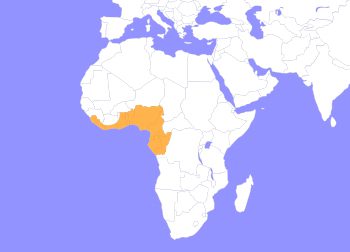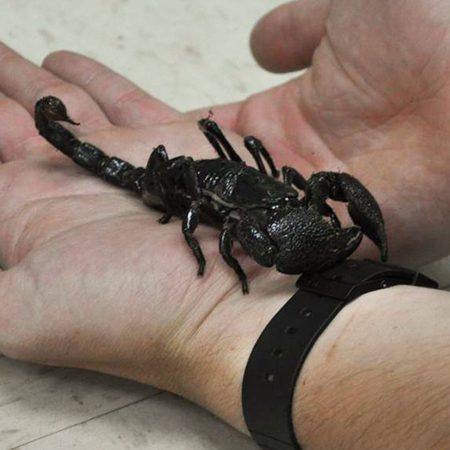Scorpion (Emperor)
Pandinus imperator
The Emperor Scorpion is a blueish-gray scorpion that is found in central Africa. They are tied for the largest (heaviest) scorpion in the world with the Giant Forest Scorpion, both are only an eighth of a pound. The Forest Scorpion is longer by a couple inches, though. The Emperor Scorpion has four segments to its body, each with two legs attached, which makes for six walking legs and two pincers. Though they generally eat insects, they can catch small lizards or rodents. They use the pincers to tear apart their prey and then inject it with venom to liquidize it and make the food easier to eat. They are also skilled at digging burrows to hide in or hunt for prey. Their lifespan is thought to be about eight years. Unlike other scorpions, they are known to live in family groups (usually the mother and offspring), making them comparably social to other species.
Scorpions create a lot of fear in people, which can be justified. They do have sharp pincers and tail with venom, but they are not aggressive animals. Emperor Scorpions especially are known for being okay with handling and generally good pets. They will not attack something bigger than them unless threatened, so acting calmly and respectfully towards the animal will result in a pleasant interaction on both ends.

They are native to the rainforests and savannas of West Africa, ranging across Liberia to the Congo.
HABITAT -They are found in hot, humid forests under leaf litter or in termite mounds.
DIET -They mainly eat termites, but will go for any insect available.
FUN FACT -They have hairs on their bodies that act equivalent to whiskers by sensing the environment around them.
SOCIAL BEHAVIOR -They are shy animals, but have been known to live in colonies up to 15 individuals.
ACTIVITY -They are nocturnal, rarely coming out before nightfall.
PREDATORS -Their predators include birds, bats, and large spiders.
SIZE -They are about 4-8 inches long and weigh less than an ounce.
RELATIVES -They are related to other scorpions, including the Striped Scorpion found here in Missouri.
CONSERVATION -They are not evaluated under the IUCN.
Cub Creek Animal Care Information
Housing - Our scorpions are housed in 5-gallon aquariums with sphagnum moss on the bottom and hides to stay under during the day and plenty of room to roam around at night. They have access to fresh water every day.
Diet - We feed our scorpions crickets. Scorpions do not need to eat often, so we only give her more when she has run out. On average, we give about 5 crickets a week dusted in calcium powder for nutrient supplementation.
Enrichment - Invertebrates get much of their enrichment through exploration of their enclosure, rather than the toys or puzzle boxes that we provide for much of our other animals. Our campers give her additional stimulation by handling her throughout the summer.


